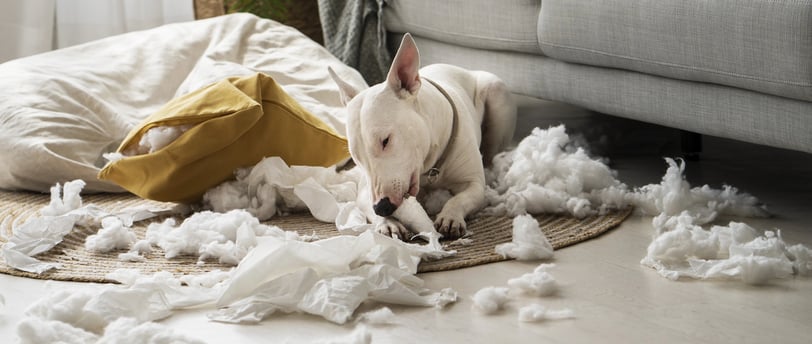How to Prevent Your Dog from Biting Furniture: Tips and Recommendations
Does your dog bite furniture, shoes, or even your hands? Destructiveness is a common issue in both puppies and adult dogs, but it’s solvable! In this article, we explain why dogs chew, how to prevent this behavior, and what to do if your pet has already developed destructive habits. Discover practical tips, positive reinforcement techniques, and when it's time to seek professional help. Help your best friend overcome this problem and enjoy a calmer, happier life together!
DOG BEHAVIOR AND TRAINING


Destructiveness is one of the most common behavioral issues in dogs, especially during the puppy stage. However, it can also appear in adult dogs, and in these cases, it is usually related to emotional problems or poor management. Below, we explain everything you need to know to understand and solve this behavior.
Why Do Puppies Bite Everything?
Puppies, just like human babies, go through a teething phase where their gums are sensitive, and they feel the need to chew to relieve the discomfort. This behavior is completely normal and is part of their development. However, if they are not taught to channel this need appropriately, they can cause damage to furniture, personal items, and even hurt people.
What to Do with a Puppy That Bites?
Provide appropriate toys: Chew toys are essential. There are various types, such as hard rubber toys, ropes, stuffed toys, and interactive toys that dispense treats. Make sure they are safe and the right size for your puppy.
Recommended toys: Kong (can be filled with food), Nylabone (for chewing), and natural rubber toys.
Avoid toys resembling prohibited objects: For example, don’t give them old slippers, as they won’t distinguish between old and new ones.
Positive reinforcement: When your puppy chews on their toys, reward them with praise, pets, or treats. This will help them associate chewing toys with something positive.
Redirection: If you see your puppy trying to chew on furniture or a forbidden object, immediately redirect them to an appropriate toy. Use a calm but firm voice.
Techniques to Avoid Biting People:
Pretend pain: If your puppy bites your hands or feet, make a high-pitched sound (like "Ouch!") and remove your attention for a few seconds. This mimics the behavior of their littermates, who would stop playing if one bit too hard.
Ignore the behavior: If the puppy persists, walk away and stop interacting with them for a minute. This will teach them that biting means the end of playtime.
Avoid punishment: Never scold or hit a puppy for biting. This will only generate fear and confusion, and may worsen the problem.
Why Do Adult Dogs Bite Furniture?
In adult dogs, destructiveness is not normal and is usually a symptom of an underlying issue. The most common causes include:
Separation anxiety: Dogs with separation anxiety may destroy objects, bark excessively, or have accidents when left alone. This disorder requires a multifaceted approach, which may include:
Behavioral therapy: Work with a canine behavior specialist.
Long-lasting toys: Kong filled with frozen food, recreational bones, etc.
Synthetic pheromones: Products like Adaptil can help reduce anxiety.
Boredom and lack of stimulation: Dogs are intelligent, active animals that need mental and physical stimulation. If they don’t receive enough exercise or environmental enrichment, they may resort to destructive behaviors to entertain themselves.
Solutions: Increase walking time, introduce intelligence games (like puzzle toys for dogs), and provide interactive toys.
Hyperactivity: Some dogs, especially working breeds like Border Collies or German Shepherds, have very high energy levels. If they don’t get a proper outlet for this energy, they may become destructive.
Solutions: Intense exercise, obedience training, and activities like agility.
Stress and anxiety: Environmental changes (such as moving, the arrival of a baby, etc.) can cause stress in dogs, leading to destructive behavior.
Solutions: Provide a safe, quiet space, use pheromones, and consult with a veterinarian or behaviorist if the issue persists.
Lack of exercise: Sedentary behavior is harmful not only to the dog’s physical health but also to their emotional well-being.
Solutions: Increase walking duration and intensity, and consider activities like running, swimming, or playing frisbee.
Additional Tips to Prevent Destructiveness
Basic obedience training: Teach your dog commands like “leave it” or “no.” This will help redirect their attention when they try to bite something inappropriate.
Create an enriched environment: Provide a variety of toys, change toys regularly to keep their interest, and consider using food dispensers to keep them occupied.
Routine and structure: Dogs feel more secure when they have an established routine. Ensure they have fixed times for meals, walks, and playtime.
Supervision: If you cannot supervise your dog, consider using a dog park or a safe room where they don’t have access to valuable objects.
Consult a professional: If the problem persists, seek help from a canine educator, trainer, or behaviorist. They can assess your dog’s behavior and design a personalized plan.
Conclusion
Destructiveness in dogs, whether in puppies or adults, is a problem that can be solved with patience, consistency, and the right approach. For puppies, it’s essential to teach them from the start what is acceptable to chew. For adult dogs, it’s crucial to identify the underlying cause and address it comprehensively. Remember that punishment is never the solution; instead, opt for positive reinforcement and create an enriched environment that meets your pet’s physical and mental needs.
